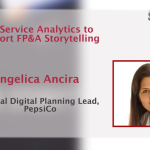FP&A Storytelling has been one of the biggest trends in FP&A over the last few years...
As organisations get to grips with data and technology, now more than ever, we see the emergence and the importance of FP&A Storytelling. So how can we apply analytics, visualisation and dashboards for better FP&A Storytelling and what are the dos and don’ts of FP&A Storytelling?
The members of the Benelux FP&A board met digitally to share their ideas and experience on the subject.
FP&A Storytelling - Challenges & Best Practices
For Simon Alexander, Director of Finance at FedEx Express, FP&As goal is to influence change through Storytelling. A key element in Business Partnering is how we tell the story. We need to listen, learn and adapt to situations. Embrace demanding audiences and learn from and explore other good storytellers.

Figure 1
Visuals are an aid to bring a story to life. However, make sure:
“A picture speaks 1,000 words” – yes, but make sure it is the right picture
Which visuals are the best tools to tell the story? – think about the recipient
Tables, graphs or pictures?
Avoid animations!
Do we use data to tell the story or tell the story about data? Always think about the story when reviewing the data!
What is the biggest barrier to effective FP&A Storytelling? 31% of the participants believed its because of inadequate skills within the team, followed closely by 26% by the poor quality of data and 22% by lack of time.
The power of FP&A Visualisation
James Haley, VP & European CFO at Nidec (ACIM Div.), shared with us the common issues faced when doing Storytelling using visualisations and they are:
The target audience is not understood
Incorrect visualisations are chosen
Slides are too busy or cluttered
The presentation of facts and figures lacks a well-sequenced narrative

Figure 2
In conclusion, James believes we should keep it short & simple, add both visuals and a storytelling narrative, create simple graphics, enrich diagnostic analyses by leveraging your visualisations and most importantly exclude unnecessary visual elements.
In our second poll, we attempted to look at what level of consistency was there in reporting/dashboarding. 22% believed there was no consistency at all. 54% some consistency with only 24% adhering to corporate design/manual and only 1% are IBCS compliant.
Value creation through FP&A Storytelling - A case study
So how do we create value through strong FP&A Storytelling? Muthumari Duraisamy, Director of Global controlling at Coty shared with us how she created value in Coty using FP&A Storytelling. Below is a case study where they looked at product margins, mix impacts, year on year and quarter analysis and how storytelling and visualisation helped them discover opportunities and risks to better the business and create value.

Figure 3
In our third poll, we looked at where are we spending most of our time. 52% of respondents spent most of their time on data gathering and reconciliation, analysis and interpretation of data was 37% with only 12% on Storytelling and Business Partnering.
The importance of Technology in leveraging FP&A Visualisation
Michael Lengenfelder, head of FP&A Product Management at Unit4, shared with us examples of standardised reporting FP&A software of today have built-in. All of them go quite a long way in themselves on Storytelling behind the data. They use lines, bars, colours, and waterfall charts, all with the ability to interact with and change and also with the options of adding comments.
Another great example is where software can give you the comparison of P&L, B/S and CF against a scenario simulation say during the Covid period showing you exactly the positive and negative variances are and with the possibility of including a story with it.

Figure 4
The picture below is a very good example of where you can bring out two or three specific areas of the business you want to look at in charts, in tables and also have specific comments you can add. This report/dashboard can then be sent to the relevant person for their review/comments before being emailed out.

Figure 5
Conclusions:
FP&A Storytelling and Visualisation is becoming one of the most important responsibilities of FP&A teams. Storytelling has to create value and ensure the right management decisions are being taken. It is very important to understand your audience, create simple graphics and visualisations, and keep it short and simple engaging your audience at all times. As we have seen technology is a big enabler in helping us tell the story with its built-in capabilities. We need to move away from excel and PowerPoint where we seem to be spending most of our time charting and tabling data which is already available and in better format with tools.
We would like to thank our global sponsors Unit4 and Robert Half for their great support with this Digital FP&A Board.
Subscribe to
FP&A Trends Digest

We will regularly update you on the latest trends and developments in FP&A. Take the opportunity to have articles written by finance thought leaders delivered directly to your inbox; watch compelling webinars; connect with like-minded professionals; and become a part of our global community.






